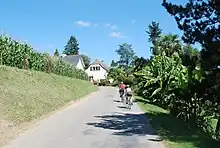Bourréac | |
|---|---|
 Bourréac looking toward Lourdes | |
Location of Bourréac | |
 Bourréac  Bourréac | |
| Coordinates: 43°06′14″N 0°00′09″E / 43.1039°N 0.0025°E | |
| Country | France |
| Region | Occitania |
| Department | Hautes-Pyrénées |
| Arrondissement | Argelès-Gazost |
| Canton | Lourdes-2 |
| Intercommunality | CA Tarbes-Lourdes-Pyrénées |
| Government | |
| • Mayor (2020–2026) | Charles Lacrampe[1] |
| Area 1 | 1.26 km2 (0.49 sq mi) |
| Population | 112 |
| • Density | 89/km2 (230/sq mi) |
| Time zone | UTC+01:00 (CET) |
| • Summer (DST) | UTC+02:00 (CEST) |
| INSEE/Postal code | 65107 /65100 |
| Elevation | 429–582 m (1,407–1,909 ft) (avg. 520 m or 1,710 ft) |
| 1 French Land Register data, which excludes lakes, ponds, glaciers > 1 km2 (0.386 sq mi or 247 acres) and river estuaries. | |
Bourréac (French pronunciation: [buʁeak]; Occitan: Borriac) is a commune in the Hautes-Pyrénées department in southwestern France near the city of Lourdes (4,5 km).
Its economy is based on residences (the village is included in the urban area of Lourdes), agriculture (animal husbandry mainly) and tourism (gîtes ruraux).

Geography
The village overlooks Lezignan and Lourdes valley as from a balcony and stays in the center of a line of low hills, 500 to 600 m high, in front of the chain of Pyrenees Mountains, with notably the foreground Pic du Jer (950m), and, in the middle distance, the summits of Cabaliros (2334 m), Hautacam (1500 to 1800 m), Montaigu (2339 m) and Pic du Midi de Bigorre (2877 m).
Crest paths starts from the village, mainly the D807 in the direction of Recahorts (hamlet of Bourréac) and, then, Pouts (hamlet of a neighbour village, Escoubes-Pouts).
Population
| Year | Pop. | ±% |
|---|---|---|
| 1962 | 36 | — |
| 1968 | 41 | +13.9% |
| 1975 | 45 | +9.8% |
| 1982 | 49 | +8.9% |
| 1990 | 46 | −6.1% |
| 1999 | 70 | +52.2% |
| 2009 | 87 | +24.3% |
Climate

The climate of Bourréac is that one mentioned by the meteo station of Ossun-Tarbes with a microclimate for special places resulting from their exposition to south and a protection from west wind. So in winter, local temperature is often 2 or 3 degrees higher than that noted in the valley of Lezignan and Lourdes.
History
Etymology
As many French words whose suffix is ac (from Latin acum ), Bourréac name comes from the name of an antique Gallo-Roman property, with the patronymic Burrius or Burrinus : the property of Burrius. On the neighbour place of Sendac, a marble Gallo-Roman statue has been discovered in 1846. It can be seen in the Jardin Massey Museum, in Tarbes.
Administration

Before 1789, during the old or Ancien Régime, Bourréac was included in the Barony of The Angles (name of a neighbouring village with a mediaeval castle).
See also
References
- ↑ "Répertoire national des élus: les maires" (in French). data.gouv.fr, Plateforme ouverte des données publiques françaises. 13 September 2022.
- ↑ "Populations légales 2021". The National Institute of Statistics and Economic Studies. 28 December 2023.